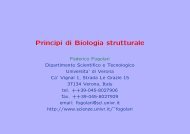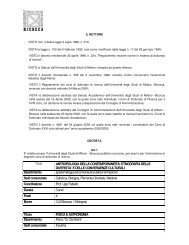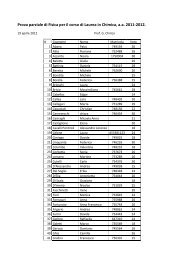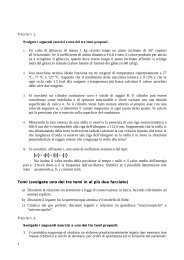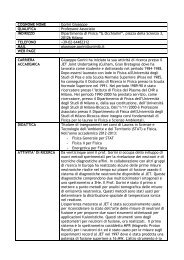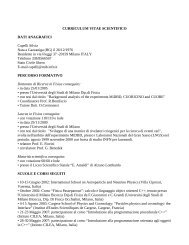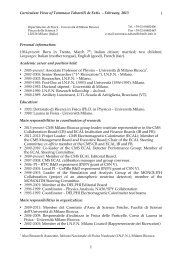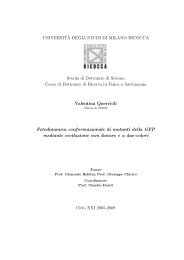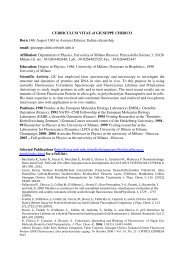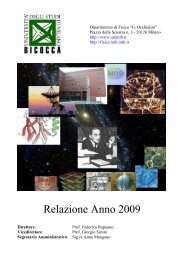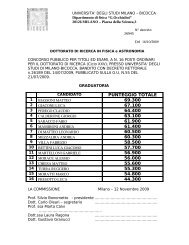Nanoparticles for in-vitro and in-vivo biosensing and imaging
Nanoparticles for in-vitro and in-vivo biosensing and imaging
Nanoparticles for in-vitro and in-vivo biosensing and imaging
Create successful ePaper yourself
Turn your PDF publications into a flip-book with our unique Google optimized e-Paper software.
20 Metal nanoparticles<br />
In eq. 1.11, ω p is the so-called plasma frequency <strong>and</strong> ɛ ∞ <strong>in</strong>cludes the contribution<br />
of the bound electrons to the polarizability. The plasma frequency is given by<br />
ω p = √ ne 2 /ɛ 0 m ∗ with n <strong>and</strong> m ∗ be<strong>in</strong>g the density <strong>and</strong> effective mass of the conduction<br />
electrons, respectively.<br />
However, the complex electronic structure of metals is not described very accurately by<br />
this model, so most calculations <strong>in</strong>volv<strong>in</strong>g metals use a dielectric function known from<br />
measurements. The measurements by Johnson <strong>and</strong> Christy [41] are generally considered<br />
to be most reliable <strong>and</strong> were obta<strong>in</strong>ed on metal films under high vacuum conditions<br />
Figure 1.6 shows a comparison between the Drude model <strong>and</strong> the values measured<br />
by Johnson <strong>and</strong> Christy [41]: whereas the low energy values are well described by the<br />
Drude-Sommerfeld model, additional contributions are present at higher energies (E>2<br />
eV). The reason <strong>for</strong> this discrepancy is related to the excitation of electrons from deeper<br />
b<strong>and</strong>s <strong>in</strong>to the conduction b<strong>and</strong>, the so-called <strong>in</strong>terb<strong>and</strong> excitations. An additional<br />
reason <strong>for</strong> the derivation from the Drude-Sommerfeld behaviour is that the conduction<br />
b<strong>and</strong> is <strong>in</strong>creas<strong>in</strong>gly non-parabolic <strong>for</strong> higher energies.<br />
Figure 1.6: (a) Real part of the dielectric function of gold; (b) imag<strong>in</strong>ary part. Experimental data<br />
(JC) from Johnson <strong>and</strong> Christy (1972) [41] compared to calculated values us<strong>in</strong>g the quasi-freeelectron or<br />
Drude model with the parameters <strong>in</strong>dicated <strong>in</strong> the graph. The shaded area around the experimental data<br />
<strong>in</strong>dicates the measurement uncerta<strong>in</strong>ty. The <strong>in</strong>terb<strong>and</strong> contribution (broken l<strong>in</strong>e) is calculated from the<br />
difference of the experimental data to the Drude model.<br />
The effect of the dielectric constants of the metal <strong>and</strong> the surround<strong>in</strong>g medium on<br />
the polarizability is illustrated <strong>in</strong> the simulations <strong>in</strong> figure 1.7; the solid l<strong>in</strong>e shows the<br />
calculated ext<strong>in</strong>ction spectrum of a spherical Au particle with a diameter of 50 nm <strong>in</strong><br />
water. The peak <strong>in</strong> the ext<strong>in</strong>ction is found at a wavelength of about 520 nm, i.e., green<br />
light is absorbed, giv<strong>in</strong>g the particles their red color. The spectrum of a Ag sphere of the<br />
same size <strong>in</strong> the same medium is also shown <strong>in</strong> Figure 1.7 (dashed l<strong>in</strong>e). The ext<strong>in</strong>ction<br />
peak is found at a smaller wavelength (at 420 nm), a direct consequence of the different<br />
dielectric constants <strong>for</strong> Ag than <strong>for</strong> Au.<br />
Chang<strong>in</strong>g the embedd<strong>in</strong>g medium to glass <strong>in</strong>stead of water (i.e., ɛ m from 1.45 to 1.33)<br />
causes a peak red shift <strong>for</strong> Ag by about 25 nm (see dash-dotted l<strong>in</strong>e). The glass effectively



